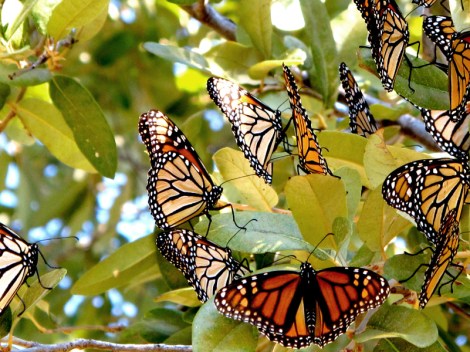The monarch butterfly species may be 250,000 years old, but it’s only taken humans about 15 to devastate their whole population. I guess we’re just overachievers like that.
A March study showed that genetically modified Roundup-ready crops were responsible for much of the monarchs’ decline. Roundup is killing off the milkweed on which the monarchs lay their eggs, and sprawl and recent droughts threaten the milkweed as well. If that weren’t enough, monarchs are losing a grip on the 60-square-mile area where they winter in Mexico. From In These Times:
Michoacáns near the state’s 12 butterfly reserves often turn to illegal logging because they have few other sources of income. It can take an illegal logger less than an hour to chop down a pine tree that has been sheltering monarchs for centuries. “From 1986 to 2006, 20 percent of the forest reserves in Michoacán were disturbed,” says Maria Isabel Ramirez, a geographer and conservationist from the National Autonomous University of Mexico. “More than 60 percent of this loss is tied to illegal extractions.”
Activists are working on both sides of the border to reestablish the monarchs’ once-glorious orangey reign, fighting the spread of Roundup in the U.S. and giving Mexican villagers better options than chopping down monarch habitat.
[T]he World Wildlife Fund, a Washington, D.C.-based nonprofit, pays Michoacán villagers to patrol forest reserves and protect them from illegal logging. Similarly, Ecolife, which is based in Escondido, Calif., provides villagers with newfangled stoves that require less pine and fir wood than traditional ovens do. And the Roseville, Minn.-based Monarch Butterfly Fund plants 30,000 seedlings per year in this threatened forest region.
In the United States, butterfly lovers are offsetting the milkweed die-off by building “monarch way stations,” such as the milkweed gardens that are now growing everywhere from a convention center roof in Pittsburgh to Debbie Jackson’s backyard in Davisburg, Mich.
If you’re planting a “butterfly garden,” though, you’re likely to attract other non-native pests like aphids, so the Los Angeles Times recommends that you get yourself some baby ladybugs.
And if you have no space to plant milkweed (coughseedbombcough), you can at least see some of the remaining monarchs in action in the new film Flight of the Butterflies. They say, “You will never think the same way about this intrepid creature after seeing the macro work of Oscar winner Peter Parks,” so that sounds promising, unless you already thought they were pretty and awesome.
[youtube http://www.youtube.com/watch?v=WTnOY_qTB2c]The film will open across the country and at the American Museum of Natural History in 2013.



